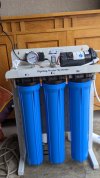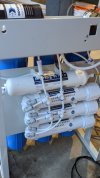As a counterpoint, I don't think the logic to running RO filters in serial versus in parallel is actually proven. Neither in theory nor in practice.
If you're thinking of switching the way it is plumbed, if that came as a unit designed that way I'd contact the company and ask their opinion. They might have an argument doing it that way it is makes more sense.
The theory to plumbing them in series (what people are saying to do) is that you're getting production for free by using the waste water of one unit to power the next. That seems logical, but it's not that simple.
The dirtier the water you feed to a RO, the higher your discharge rate, the dirtier "clean" water will come out, and the faster you burn through RO membranes. So the second membrane will be doing a worse job than the first, produce less, and wear out faster. It also will have lower input pressure into it, again making it less efficient.
If you do it in parallel (how yours is setup), each will be working at the same efficiency (in theory their maximal efficiency). That's certainly going to lead to the highest water production rate.
How much relative waste one versus the other produces seems unclear. It seems like something that could be interesting to do a test on though. For 10L of input, how much total clean output do you get in one setup versus the other. Similarly what's the final TDS of the clean output.
Measuring the membrane wear I don't how you would do. Probably could estimate it if you measured TDS of the input water at each stage of serialness
The parallel one should increase production linearly (assuming the pump and prefilters can keep up). With more RO membranes in parallel it seems you should just be making water faster, with the same ratios and wear as using one membrane. The wear just gets spread across multiple membranes.
The serial one it seems like you don't get slightly dirtier output, higher membrane wear, but presumably use a bit less input water. In theory wasting less input water, at a cost of wasting more RO membranes and DI resin.


